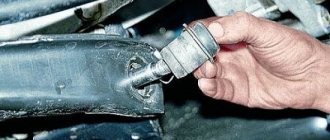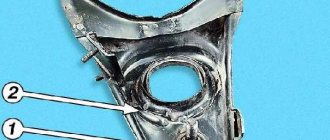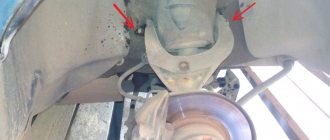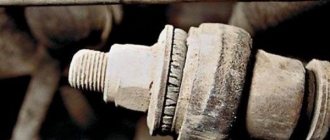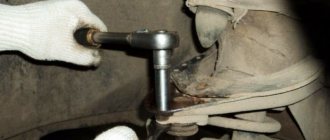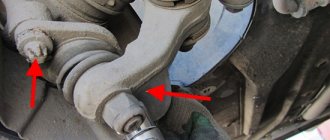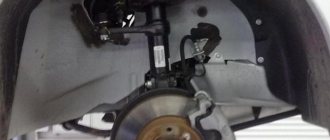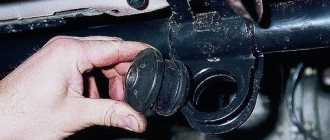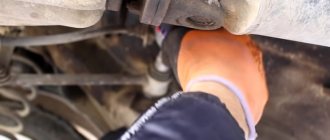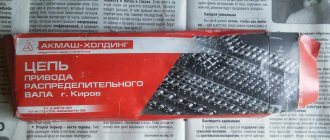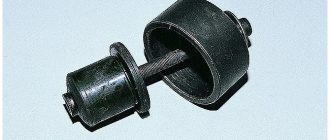Replacing the silent blocks of the front levers on VAZ 2101 - 2107 cars is not an easy task. However, they still need to be changed from time to time, and most car enthusiasts have learned to do this without much difficulty. A special universal puller will help to significantly simplify this work. It is with its help that both the upper and lower silent blocks are replaced.
So, you have come to the conclusion that it is time to replace the silent blocks. You should start by purchasing them. Today there are many domestic and imported products on the auto parts market. They differ from each other in price, quality, and service life. Experts recommend installing polyurethane ones as the most reliable and durable, however, due to the fairly high price, they are not affordable for everyone.
For the replacement process itself, it does not matter at all whether the silent blocks are polyurethane or rubber; they are changed on the VAZ 2107 in exactly the same way. From the tool you will need:
- Silent block remover;
- Ball joint remover;
- Keys for 13, 22, 24;
- Hammer;
- Chisel;
- Mount;
- Penetrating lubricant (eg WD-40).
You should start by hanging the front end on a jack and removing the front wheel. Next, we proceed directly to the replacement procedure. For the upper and lower front arms of the VAZ 2107, the order of work is different, so we will consider both options. To simplify the work, it is recommended to pre-treat all threaded connections of the levers with penetrating lubricant.
Diagnostics of silent blocks in the front control arms.
Why do silent blocks need to be changed over time? There are several reasons for this:
- Over time, rubber loses its elastic properties and begins to crack.
- During use of the machine or during its maintenance, oil got onto the silent block.
- Incorrect installation of the part.
- Driving on very bad roads, of which there are a great many in Russia.
Everything is diagnosed quite simply. The first thing that should alert you is the deterioration in the responsiveness of the steering wheel. But this may not be the case only, let’s look further. The second sign of dead silents, the wheels are standing like a house. On the pit or on the lift, check the integrity of the rubber bands (they should not have cracks and they should not be squeezed out). You can take a crowbar or a pry bar and try to move the levers. They should not have free movement (should not dangle).
Preparing for work
Replacing silent blocks begins with selecting the necessary parts. If you make a mistake at this stage, there is a possibility that the next repair work will be approaching.
Drivers often buy parts made of rubber. But they have certain disadvantages - they creak and collapse quite quickly. Experts recommend using polyurethane silent blocks. They cost more, but are more durable and have a longer service life.
This element should be changed as soon as a strong creaking or knocking noise appears. The need for replacement is determined visually. The occurrence of cracks, scuffing, and deformation are the main causes of failure. A silent block malfunction can have a negative impact on all suspension elements.
Replacing silent blocks in the upper control arm of a classic with your own hands.
So, let's begin! In rear-wheel drive VAZs, the silent blocks in the upper arm can be changed without even driving into a hole and without removing the arm from the ball (provided that you have a remover for silent blocks). But first you need to determine whether the bushings of the silent blocks are stuck to the bolt securing the lever to the body. To do this, jack up the car and remove the wheel.
Arrows point to bolt and nut
We loosen the nut securing the upper arm with a 22mm wrench and try to turn the bolt. If it spins and the bushings stay in place, then you're in luck! But if this bolt rotates with great force and the bushings rotate with them, then as they say: “Houston, we have problems!” Next we will consider both cases.
If the silent blocks are not stuck.
Further actions depend on whether you have a puller for silent blocks. If there is one, then you don’t have to remove the lever completely, but just unscrew the nut 22 to the end, take out the bolt and turn the lever towards yourself (for the convenience of further repairs).
We turn the lever for convenience.
Next, take a puller and press out the silent blocks.
Removing the silent block using a puller
And with his help we press in new silent blocks. Before pressing, the mounting hole must be cleaned and preferably lubricated with lithol. In the upper arms, silent blocks are pressed into place up to the ribs, as shown in the photo below.
The new silent should be pressed in exactly like this.
But what to do if you don’t have a silent block remover ? Then you will have to completely remove the lever. We take out not only the bolt securing the upper arm to the body, but also take out the ball from the hub (this is faster than unscrewing 3 bolts securing the ball to the arm). Detailed removal of the ball joint is written here.
We removed the lever, put the lever ear on a pipe or on a yew tree (as in the photo), the main thing is that the silent block does not rest against anything, and knock it out with a hammer.
To press in new ones, we need a mandrel (old bearing, piece of pipe, nut head). The inner diameter of the mandrel must be equal to the diameter of the skirt of the new silent block. And we begin pressing in new parts using this mandrel, having previously lubricated the seat with lithol. Reassemble in reverse order.
Important: we pull the bolt securing the lever to the body only under the load on this wheel! Those. The car should not be on a jack, but on all wheels!
If the silent blocks are stuck to the bolt.
This is a very difficult case, since you will have to spend a long time trying to get the bolt that secures the front upper arm to the body.
For those who want to save themselves a lot of time and are ready to fork out a little, I advise you to buy a new bolt, this lever from disassembly and just cut off the old bolt with a grinder.
Well, if you have time and nerves, then we take a gas burner in our hands and burn out the silent block. Follow fire safety precautions! After all the rubber has burned out, you can begin to knock out the bolt. Get ready to do this for a very long time. After you remove the bolt, knock out the remaining clip of the burnt silent tape from the lever and follow the instructions written above.
What happens if you don’t change the silent blocks for a long time?
Increased roll during turns indicates wear on the silent blocks of the transverse stabilizer
Worn or torn silent blocks do not prevent the vehicle from moving. Therefore, if a malfunction occurs while on the road, you can carefully drive to a garage or car service center to have the breakdown repaired. However, long-term operation of a car with faulty rubber-metal joints is extremely undesirable, as it leads to more serious breakdowns and affects driving safety.
Firstly, a car with worn silent blocks handles worse and behaves less predictably on the road, which is, at a minimum, uncomfortable. Secondly, if the rubber does not absorb shock and vibration loads, then other parts associated with the silent block are subject to accelerated wear. Finally, thirdly, with significant wear of the joint, due to loss of control increases
All the likely consequences of untimely replacement of worn or torn rubber-metal joints are collected in the table below.
What will happen if you don’t change the silent blocks: possible consequences
| Worn node | What does it lead to? |
| Front arm silent blocks | Deviation of the vehicle from the trajectory of movement and a decrease in directional stability. |
| Accelerated wear of tires and upper strut mounts. | |
| Silent blocks of stabilizer struts | Increased roll and lateral movement of the body. |
| There is a risk of a car with a high center of gravity overturning when making a sharp turn. | |
| Silent blocks of transverse suspension arms | Accelerated and uneven tire wear. |
| Loss of directional stability. | |
| Wear of subframe silent blocks | Jerks and “pecks” when starting and braking. |
| Vibrations and sagging of the power unit. | |
| Separation of the subframe from the body when falling into a hole. | |
| Chafing of wires, tubes and hoses running close to the subframe. | |
| Silent blocks of the frame on a car | Excessive body sway. |
| Chafing of wires, tubes and hoses running close to the mounting points of the frame and body. | |
| Partial separation of the frame from the body when involved in an accident or a large pothole at speed. | |
| Engine or gearbox silents | Jerks when starting and braking. |
| Increased load and accelerated wear of drives (CV joints, axle shafts). | |
| Engine and gearbox shaking. | |
| Knockout of gears and wear of shift mechanisms (on cars with rigid rocker links). | |
| Wear of rear silent blocks of struts | Vertical swing of the body. |
| Accelerated wear of the upper cushions (supports) of the struts. | |
| Wear of rear beam silent blocks | Loss of directional stability. |
| Deterioration of controllability and increased tendency to skid. | |
| Transverse jerks and body rocking. | |
| Tires touching the fender liners when cornering, accelerating tire wear. | |
| Incorrect distribution of braking forces on a car without ABS with “sorcerer”. |
When operating a car with failed rubber-metal joints, the fasteners wear out and the parts themselves in which they are installed, the wheel alignment angles are disrupted.
For example, on old front-wheel drive VAZs (2108-2115), a worn lower arm silent block can cause the mounting holes of the lugs on the side member to break. After this, it becomes difficult to adjust the camber, and even well-tightened bolts loosen faster.
Why do silent blocks creak?
In the early stages, a harbinger of problems is the creaking of silent blocks, which occurs for the following reasons:
How to determine which silent blocks squeak: video
- loose fasteners;
- incorrect tightening position (not under load);
- rubber contamination;
- separation of rubber from metal.
If the creaking occurs due to the fact that the silent block bolt is loosened, and the problem is identified at an early stage, there is a high probability that you can get by with a simple tightening to the torque specified in the car repair manual. The same applies to silent blocks tightened in the wrong position (on a relaxed suspension). If the squeak occurs after an unqualified replacement of the rubber-metal hinge, it is necessary to loosen the tension and tighten the nut again on the loaded suspension.
If the silent block squeaks after rain, but not in dry weather, dirt may get on the rubber. This is especially true for inserts that have slots. This problem is solved by cleaning them and applying lithol, silicone or graphite grease to the surface. But in some cases, creaking in wet weather also occurs when the bushing comes off, which can be torn off from the rubber part as a result of turning. In this case, an immediate replacement of the element is required.
Replacing silent blocks in the lower arm of a VAZ 2107, classic.
Here, when replacing, we can no longer do without an inspection hole or a lift.
To begin, use a 24mm wrench to unscrew the nuts securing the lever. Next, if you have a puller, then use it to press out the silent blocks. If there is no special puller, then we simply take a mandrel with a diameter larger than the diameter of the silent block. We set the mandrel as shown in the photo and hit it with a hammer. At the same time, we rest the lever using a mounting tool or a crowbar, as in the photo. Thus, we remove the silent blocks in the lower arms.
Remove silent blocks without a puller
How to remove stuck silent blocks in the lower front control arm.
Stuck silent blocks cause a lot of trouble when removing them. In order to get rid of them you need a gas torch and a hammer with a core. We burn out the rubber and tap the iron bushings on all sides. After that we try to knock them out using a core and a hammer.
If the nuts securing the lever shaft are not stuck, then it is better to completely remove the lever (this will make it easier to knock the bushings out of the shaft). To do this, you will also need to remove the ball from the hub. Above in the article there is a link on how to remove the ball joints.
Pressing silent blocks into the lower arm.
New silent blocks are pressed into the lever until it stops. This can be done using a puller or a mandrel of a suitable diameter; you can use a head as a mandrel.
After installing the new levers, tighten the nuts and release the car onto the wheels. Only after this do we fully tighten the nuts.
Of course, it will be clearer to see how everything is done once than to read it a hundred times. Especially for you, I am attaching a video about replacing silent blocks in the front arms of a rear-wheel drive VAZ.
Replacement of rubber bushings of torque rods.
To remove the rubber bushing, we need to knock out the metal inner race (bushing). After rummaging through my toolbox, I found a suitable attachment. I don't know what it is, but it fits just right. replacing the brake pads of the rear wheel brake mechanisms on a VAZ 2107. Replacing the silent blocks of a VAZ 2107 with your own hands. In my opinion, this is a tool for punching holes in the wall, like an ancient hammer drill :).
Next I used the vice as a stand. After a few good hits with a hammer, the bushing came out.
Silent block and signs of wear
A silent block, also called a rubber-to-metal joint, is an important part in the design of a car. This part is widely used in suspension, as it allows you to connect parts in such a way that vibrations, shocks and other phenomena that occur during movement are damped precisely at the junction of different components. Thus, hinges are fastening elements for torque arms, stabilizer struts and many other suspension elements.
Structurally, the part is a compound of rubber and metal. Over time, the rubber part of the silent block wears out, as a result of which it cannot fully perform its functions and characteristic symptoms of its wear appear. It is worth understanding that if you do not promptly replace a worn-out hinge, there is a considerable risk of damage to the metal suspension parts that it connects. This outcome of events is not only unpleasant, but will also provoke repairs in a larger amount than what would be required to replace the silent block itself.
The most pronounced signs of wear on a part are:
- the appearance of a knock from under the car;
- body swaying when driving;
- uncertain movement of the car on the road.
Having recognized such symptoms in themselves, each car owner needs to carefully inspect all suspension joints for wear. If the rubber part of the part is deformed, cracked or completely crumbled, repairs are inevitable and must be carried out as soon as possible.
Important! Using a car with worn silent blocks is not only dangerous for the condition of the remaining suspension components, but also risky for the driver himself and the passengers of his vehicle. Don’t forget, suspension faults, even the most minor ones, can cause an accident.
